Raising chickens (or any variety of animals) you must be sure they are also prepared for any hardships on your homestead. Learn what to feed chickens during the winter with these helpful tips!
Chickens Survival Tips For Winter
If I’ve said it once, I’ve said it a million times…homesteading is not for the faint of heart. This pertains not only to homesteaders themselves, but to all your livestock as well. During winter the need of all who dwells on the homestead is on a different level. If you have a flock and want to be sure they'll survive the winter adversities, then you'll need them well prepared with a protein boost in their chicken feed.
Chickens During Winter
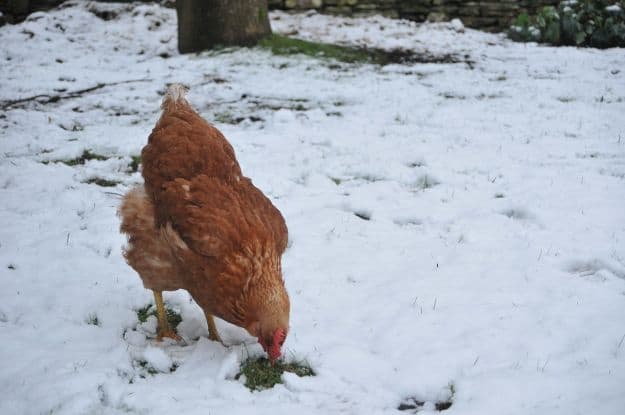
Due to the fact that chickens’ laying habits are directly related to the number of hours of sunlight they get per day, many birds have stopped or significantly slowed down their laying by the beginning of November.
Some people counter this by putting a light in their coop, but I don’t like to do this for two reasons: one, birds only have a certain number of eggs in their ‘system’. The sooner you use them up, the sooner the bird’s useful laying life is over. This doesn’t feel natural to me, so I don’t do it. Two, I simply don’t like running power to my coop. Any form of electricity, heat or light in there is a fire hazard, and I hear too many horror stories.
There are other ways to keep your birds laying as long as possible though, and some will continue to lay through the cold weather and shorter days, gifting you an egg now and again, you lucky thing! A protein boost through fall and winter will help your birds survive the ice and snow, feather themselves if they’re having a late molt, and perhaps encourage them with the odd elusive egg or two.
Ways To Boost Your Chickens’ Protein
1. Switch To A Game Bird/Grower Feed

Game bird/grower feeder usually have 18-21% protein depending on brand. Alternatively, you could cut some Calf Manna in with your feed, according to the directions on the bag. The pellets are small enough for even the little bantams.
2. Bug Board
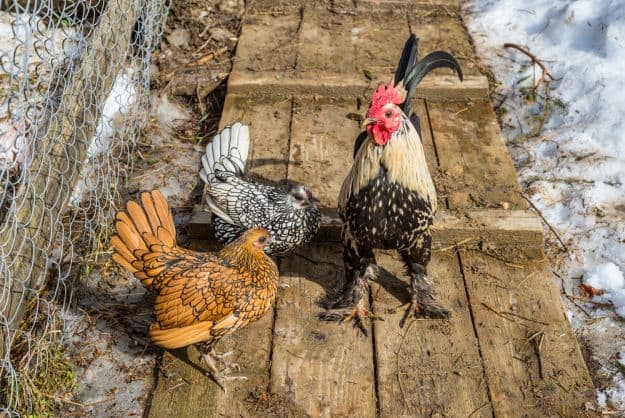
I love this one! Take a scrap piece of OSB or pressboard or whatever you have laying around, and put it down flat on the ground. Bugs, worms and other delicious things will crawl under the board for warmth and shelter. Leave it a few days, then flip the board over and let the birds go crazy on the candy farm you just made them! Just keep moving the board around every few days. I had some leftover rubber matting from inside the barn, so I use a scrap of that. It works well, and doesn’t rot like wood. The holes in it make it easy to lift and drag around.
3. Give Your Chickens Some Eggs
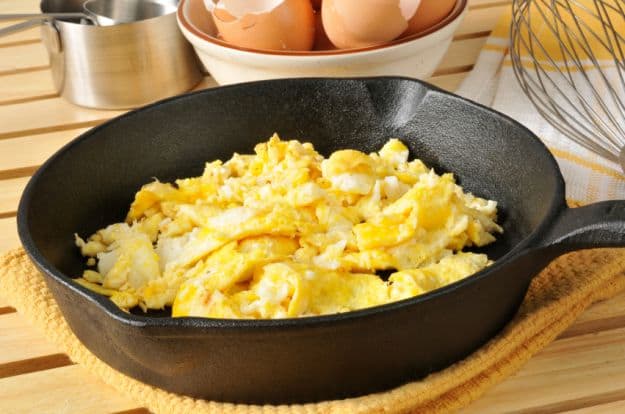
I imagine that any eggs you do have will be highly valued – far too much so to be feeding them back to the chickens – but if you do have any spares, scrambling or boiling them and feeding them back to the birds will give them a valuable protein and nutrition boost. Add a little garlic powder and cayenne pepper for a natural de-wormer.
eight:17px; margin-bottom:0; margin-top:8px; overflow:hidden; padding:8px 0 7px; text-align:center; text-overflow:ellipsis; white-space:nowrap;”>A post shared by Homesteading (@homesteadingusa) on
4. Kitchen Scraps Are Great For Chickens And Save On Your Garbage Output
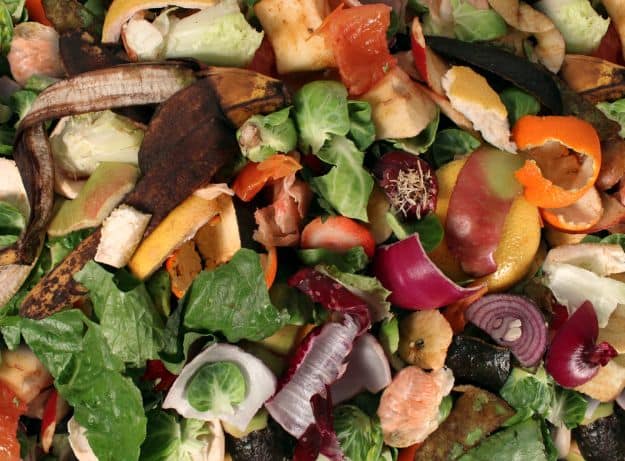
Any meats, dairy, vegetables, fish, carbs you have, throw them in a bowl and take them out for the birds. Just avoid any heavily salted or sugared foods.
5. Birds Love Cat Food
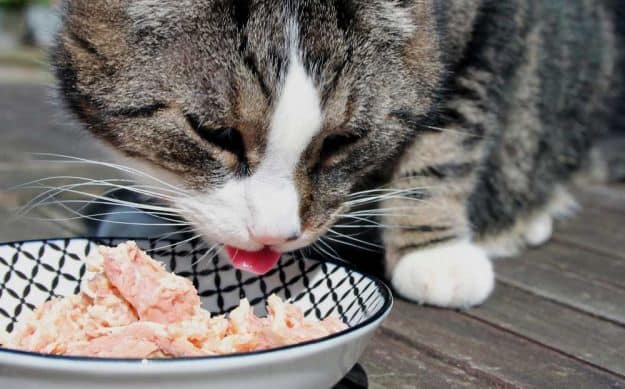
It’s a weird thing, but it’s true. Cat food also tends to be around 30% protein, which is great for them, so if you want to give them a special treat, grab them a bag the next time you’re at the grocery store.
6. Free Range

Unless you’re concerned about flying or four-legged predators, try letting your girls free range during the day when it’s warm. They can scratch about and find bugs and other things to eat – helping you out with the feed bill!
Now that your chicken feeds are set, let us watch this cute video from MrLotineGuy of chickens seeing snow for the first time:
That's it, my fellow homesteader! You can now sit back and look forward to February – your girls should be ready to show you some love in the form of eggs by Valentine’s Day!
How do you keep your Chickens well fed in the cold months? Share with us in the comments section below.
Up Next: The Best Egg Laying Chickens For Your Homestead
Follow us on Facebook, Instagram, Pinterest, and Twitter!
Editor’s Note – This post was originally published on December 2015 and has been updated for quality and relevancy.


 ||
||  : @happydaysfarm
: @happydaysfarm

Thank you so much for the atical , however I wis to know haw one can rear free lange chicken during winter ? For Goats, what would be the best feeds yo ffed them during wintrr time ?
In looking at the picture, my experience tells that trying to use the citrus rinds for feed is a waste of time. The chickens won’t eat then and they don’t compost easily because of the microbial inhibitors present in the citrus oils. I wouldn’t rule out the possibility that these oils serve in an insect repellant capacity, of which I am unaware.
At the time, we had a small Kubota tractor with which we could use to scoop the coop annually, removing all droppings from beneath roosts down to subsoil, then till the subsoil down eight inches or so before adding a light layer of top soil, a few cartons of fishing worms and a couple dozen night crawlers before breaking open a full bale of straw or partially spoiled bale of grass hay. The chickens worked the spreading themselves,culling much of the free seeds. The worms were able to secret themselves deep enough into the tilled soil so as to avoid poultry detection. As the season progressed more bedding was added, including the fine sawdust from my router and table saw. By the following spring, we were left with removing almost a full cu./yd. of worm casing enriched top soil to apply to the garden.
I haven’t tried it but, I’ve heard that warm beets are good for the chickens in the winter. We are hitting double digit wind chills this week but I am still getting eggs; 7 today from 18 hens. I’m happy with that on a frigid January day! The chickens of course have not been out of their house today, way too cold. Their house is well insulated with bales of straw (it was a convenient place to put it) though, I’m wondering how many mice are enjoying that straw also and how to best get rid of them.
Thanks. I do have catfood, lots…may give them a little. Have been feeding some scrambled eggs in with some oatmeal. They love it. Two of my four have started laying again a few days ago. I have not tried to force them to lay with artificial light either. I figure they work hard all year and need to recoup those body stores for colder weather. Fortunately, this winter has been relatively mild so far. Only 2-3 nights in single digits. In the 60s here today in middle Tennessee. Thanks for the suggestions about the game bird feed. I have noticed that the feed I give them does not have any animal protein in it at all, and it is a major name brand.
Hens generally don’t require higher levels of protein in their feed in the winter. The amount of protein they need each day is fixed depending upon stage of growth and rate of lay, but doesn’t change with seasonal temperatures. A standard 16% layer ration has the correct level of protein for average consumption in moderate temperatures. When the weather is cold they need more calories, and eat more feed. Their intake of protein is then higher than normal. Feeding a little bit of scratch in the winter gives them the extra calories they need without consuming expensive protein that is in excess of their requirements.. Conversely, in the summer when consumption is down due to high temperatures, higher levels of protein in the feed help to get the required protein into them.
The limiting nutritional factor in the winter is energy (calories). In very cold temperatures, some hens can’t eat enough feed (especially with shorter days) to keep up with reproduction. Supplemental light not only induces them to lay, but gives them more time with food in their digestive system, versus sitting on a roost in the dark for 12-15 hours.
Hi,


I absalotly love this sight
How ever i was wondering if you could tell me where to go to find people who are off the grid minded and want to help us get started on our farm. We are an older couple and have raw land on an island only a few people live there and to be honest we just cant do it all our selves. Iam concerned about having strangers becoming apart of our lives. How do I find some one or people to help ud that we can trust?
Thanks , Rebecca
Fresh alfalfa and earthworms, crickets, meal worms and soldier fly larvae (there are plenty of articles on how to raise these creatures on the Internet) are a far better option than most of those covered in this article. Chickens are fiercely carnivorous and will kill and eat rats, mice, snakes and baby birds if they come across them.
Despite what most people think, chickens do NOT need much grain, but do far better in a free range setting where they devour almost any insects they encounter and also eat a lot of greenery, which gives the yolks of their eggs a deep orange colour, as opposed to the sickly yellow yolks city folks have come to know. Free range chicken meat is RED, not the anaemic colour of shop-bought chickens, which are often raised in the dark, under the most appalling, overcrowded conditions.
When scrambling eggs, how many eggs per pullets is a good number? I have 8 pullets, and so far have been doing about 5 eggs between them. Also how often would you recommend giving them this treat? Thanks!